
Die wirkliche Farbe: Über Farbe und Wirklichkeitstreue
(true color: about color and truethfulness)
For my BA thesis/project I contemporaneously researched, wrote my thesis, explored how I could translate thoughts visually, sketched and did hands on prototyping. It went back and forth, often overlapped, but mainly everything influenced each other. A working method that was inspiring, but in my eyes also extremely necessary when talking about color – specifically also skin color –, technology – mainly photography and film –, representation, power structures and responsibilities.
In the course of this work I developed 6 projects that are linked to specific text passages in my thesis: color gradient (1) questioning the rigid categories we have defined for a fluid color spectrum; defining colors (2) touching on the absurdity of thinking that ‘objective’ color definitions work and the trust we give technology in being an ‘objective’ part (in this process); black and white reality (3) seeing that for a long time people lived in different ‘(color)realities’ and exploring how it is to walk trough a ‘black’ and ‘white’ world not just on photographs and in videos, but in real life; color composition (4) as well as hues (5) looking at the multitude of continuously changing hues each and everyone carries with their skin and the absurdity of assigning people to specifically determined color categories; and mirrored (6) with the truecolors toolkit I specifically designed learning how technology is calibrated, the interests, processes and power structures behind them, and seeing what effects (my) decisions (can) have. Feel free to read my thesis (in German).
–––––
tasks: concept, research, writing, prototyping, building, layout
2021 / Berlin University of the Arts (BA thesis & project)
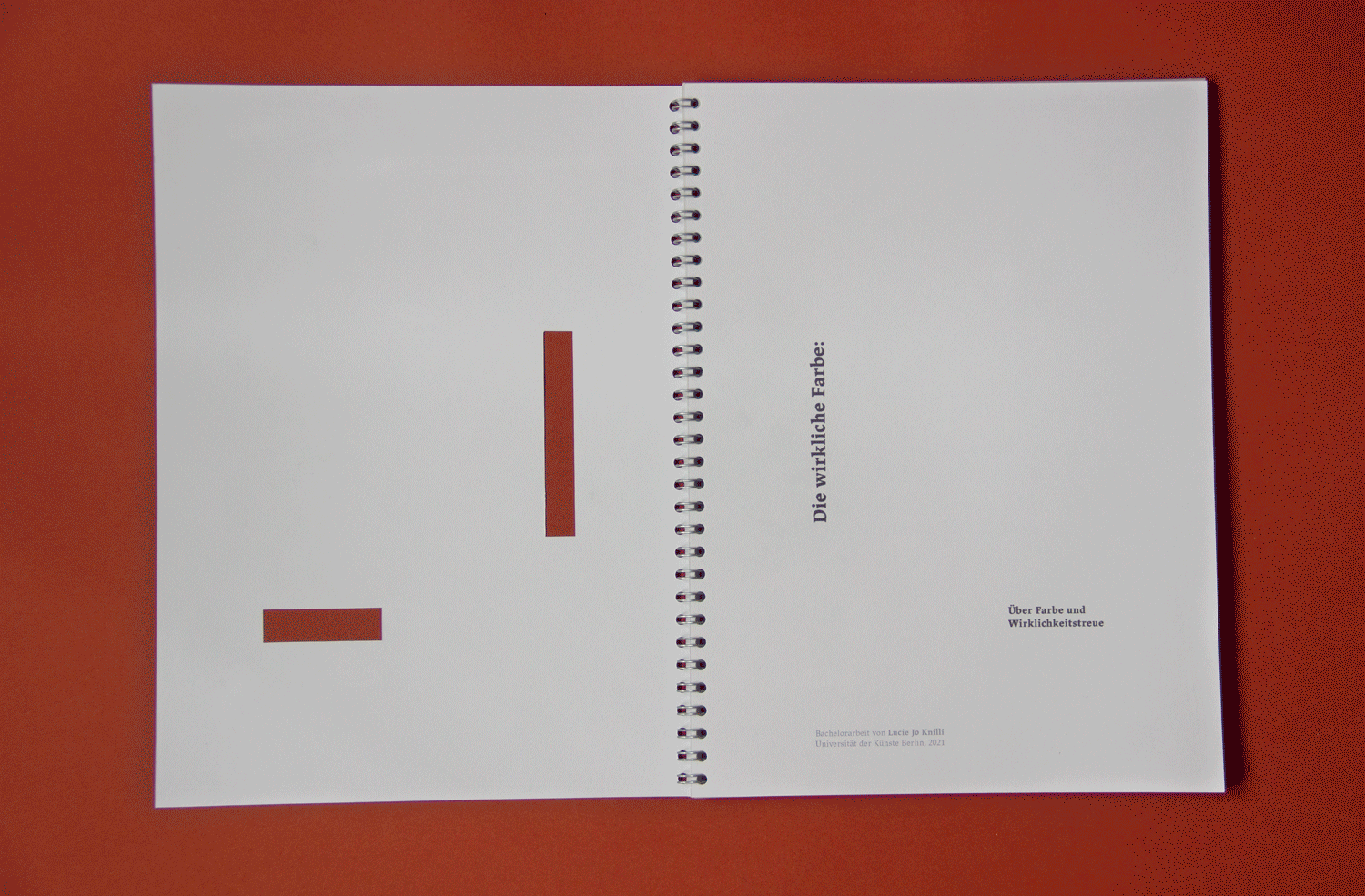
















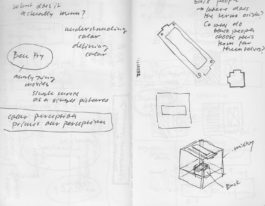
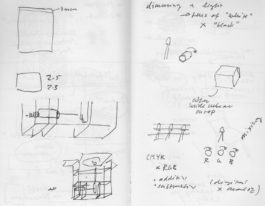

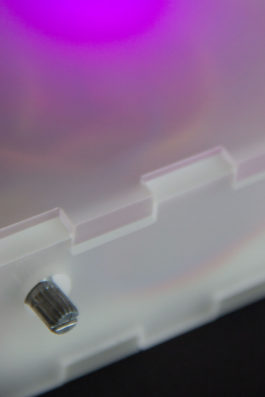
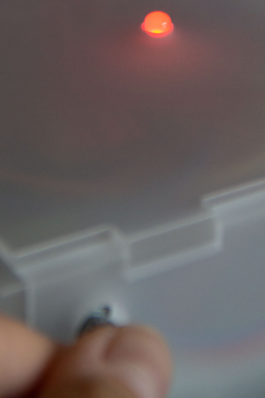
(1) color gradient
“Wir können zwar versuchen, Farbwerte mit Hilfe von Sprache zu vergleichen, doch ist es uns nicht möglich, anhand dieser abzuleiten, was die*der Sprecher*in ‚wirklich‘ sieht. Denn Farbbezeichnungen, wie beispielsweise ‚Gelb‘, ‚Grün‘ oder ‚Blau‘ setzen dem fluiden Farbspektrum scharfe Grenzen und gleichzeitig gehen wir mit diesen Bezeichnungen auch sehr ungenau um” [While we can try to compare color values with language, we can not determine what the person speaking ‘really’ sees. Color terms such as ‘yellow’, ‘green’ or ‘blue’ set sharp boundaries to a fluid color spectrum and at the same time we are very imprecise with designating these.] (Knilli 2021: 10ff.).
This work questions the rigid categories into which colors are often squeezed. With the help of a rotary knob one can find color values ‘in between’ – color values that often can not be clearly assigned to a specific color term. The ‘determined’ colors are therefore much more based on subjectivity – an individual interpretation – in contrast to the technical components, to which objectivity is usually ascribed.
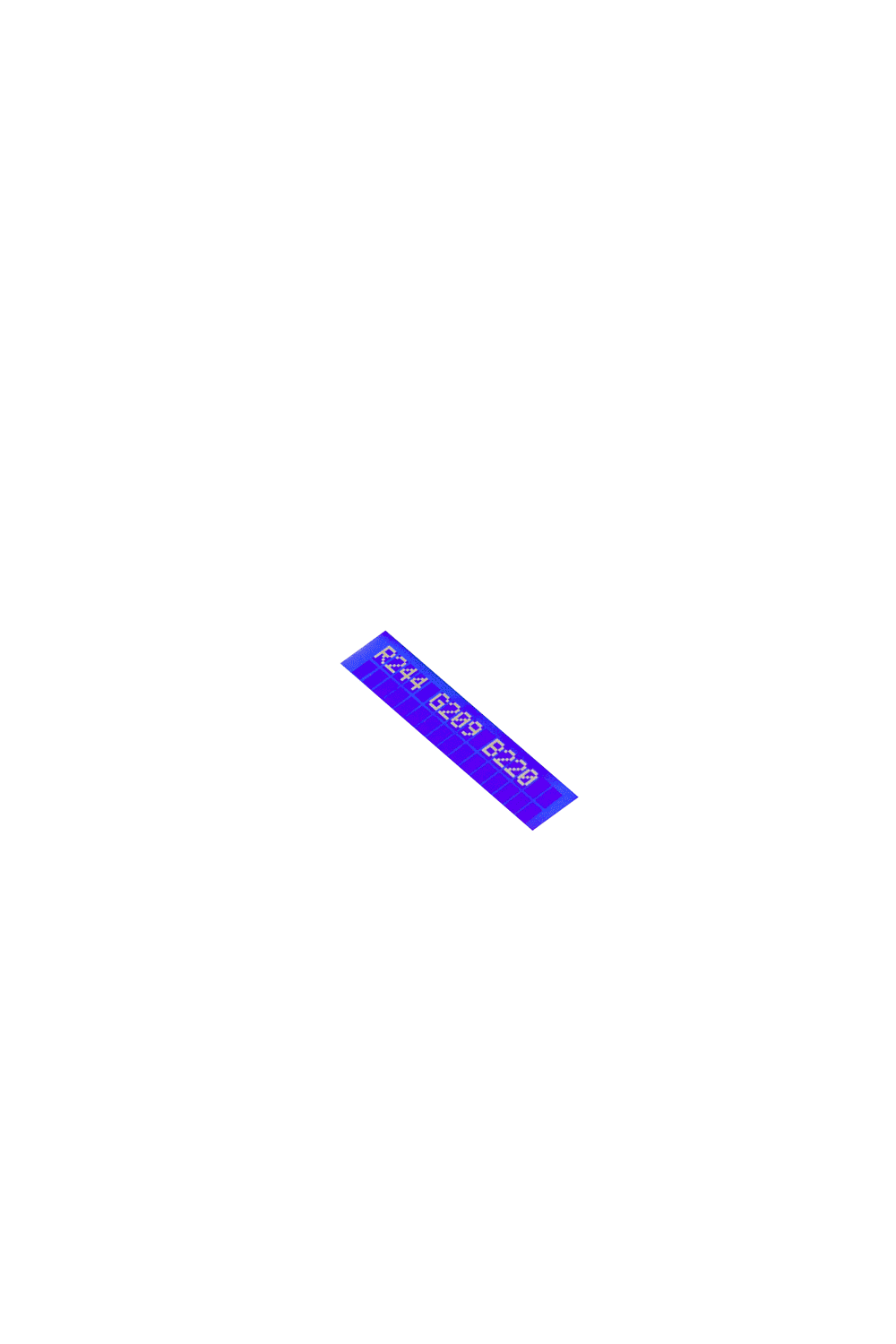
(2) defining colors
“Eine von Geburt an nicht sehende Person würde meinen, dass ‘Farben wie Schach oder Mathe ein rein gedankliches [Konzept] sind. [Sie sind] abstrakt. [...] ‚Grün‘ und ‚Blau‘ sind wie Vokabeln [unter denen ich – Jonas Hauer – mir] nichts optisches vorstellen kann’” [A person without sight since birth would think that “colors are like chess or math a purely mental concept. They are abstract. ‘Green’ and ‘blue’ are like vocabulary among which I – Jonas Hauer – can't visualise anything.] (Knilli 2021: 11).
‘R244’, ‘G209’, ‘B220’ – What color is that? ‘RGB’ is another construct, a standardization and an attempt to describe and define colors ‘objectively’. But even if someone is familiar with the logic behind this definition and objectively seen it describes colors a lot preciser, most people probably don't really know which hue it describes. The only thing most people might know is: the tone is likely to be lighter rather than dark since the values are closer to 255 than 0 and that the color will lean towards ‘red’ rather than ‘green’ or ‘blue’ since ‘R’ is the highest value. On the other hand, if one would use color descriptions such as ‘red’, ‘pink’, ‘lilac’ or ‘violet’, one would most likely immediately have visual images in mind.
This project also plays with the trust people place in technologies and in this case specifically in color codes. One assumes an ‘objectivity’ that is often misleading, because it is not visible that devices are programmed and calibrated by individuals and are therefore ‘subjective’. Technology can never be fully ‘objective’, no matter how hard one tries.
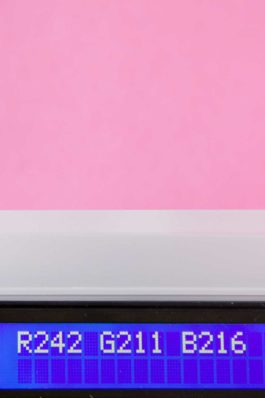
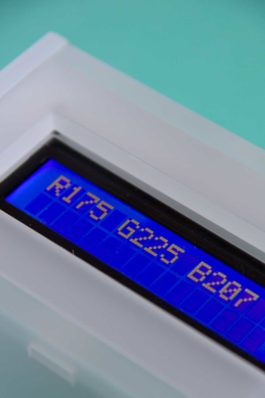
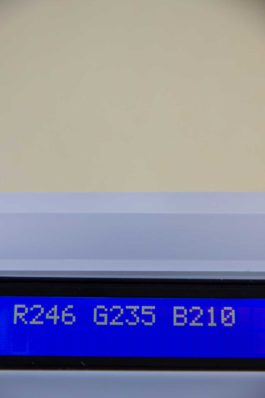

(3) black and white reality
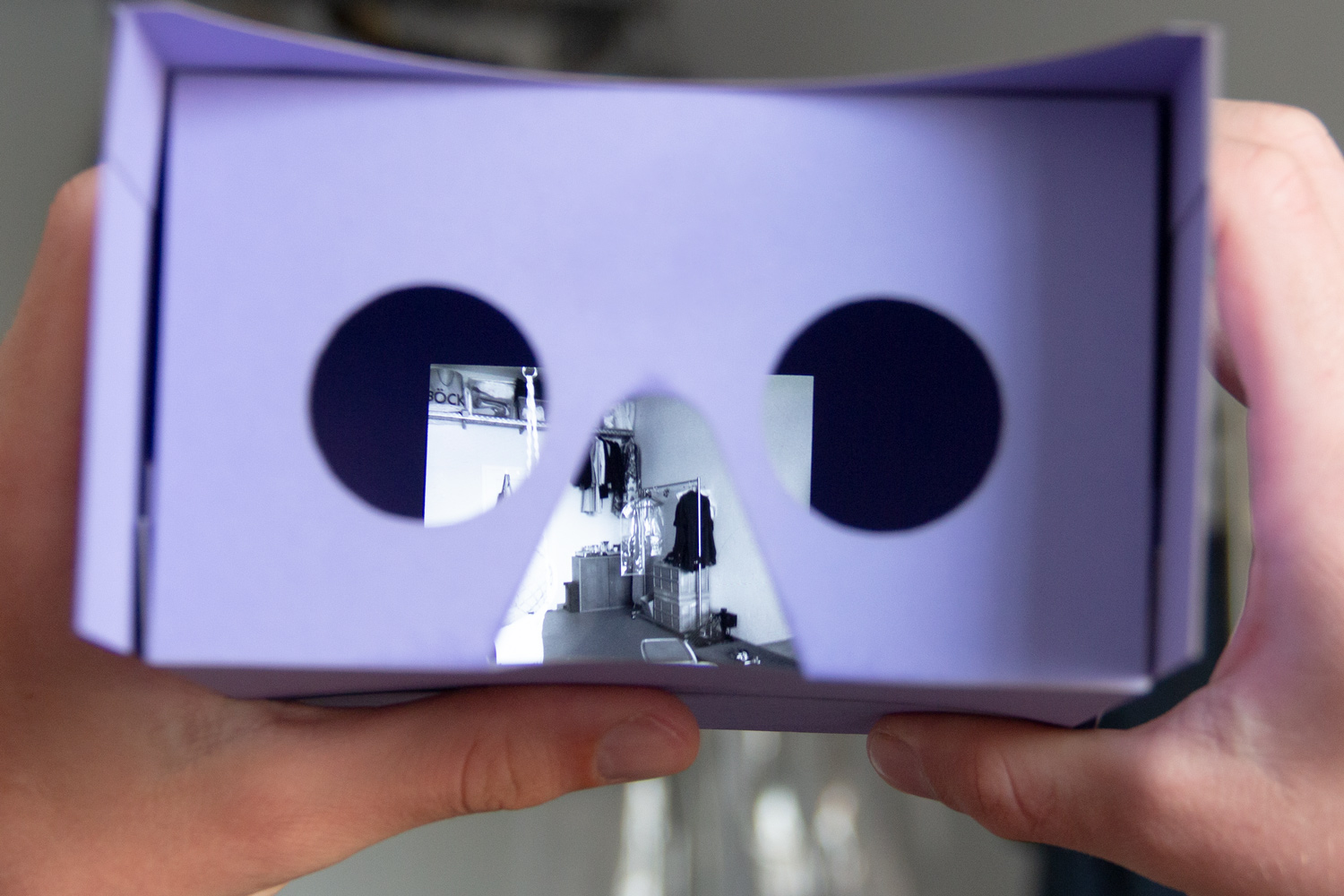
“Lange war es auch technisch gar nicht möglich, eine ‚objektive‘ optische ‚Wirklichkeit‘ einzufangen. Erst mit der Erfindung der Fotografie Mitte des 19. Jahrhunderts und einige Jahrzehnte später dann auch mit dem Durchbruch des Filmes – beides ‚schwarz‘-‚weiß‘ – hat sich diesbezüglich viel verändert, denn Fotografie und Film wurden als wissen- schaftliche Werkzeuge eingeführt, die bis heute in der Regel ‘als exakt [und] empirisch, gänzlich im Dienste der Authentizität, Realität und Objektivität’ gesehen werden. Aber selbst ‚Schwarz‘-‚Weiß‘-Fotografie und -Film stellen eine gefilterte Version der visuellen ‚Wirklichkeit‘ dar, da das ‚Schwarz‘-‚Weiß‘-Bild für uns Menschen in der Regel nicht im realen Leben existiert” [For a long time it was also technically impossible to capture an ‘objective’ visual ‘reality’. Only with the invention of photography in the mid 19th century and a few decades later with the breakthrough of film – both ‘black’ and ‘white’ – a lot changed in this regard. Photography and film were introduced as scientific tools, which to this day are usually seen as “exact [and] empirical, wholly in the service of authenticity, reality and objectivity”. But even ‘black’ and ‘white’ photography and film represent a filtered version of visual ‘reality’, since for us humans the ‘black’ and ‘white’ image usually does not exist in real life.] (Knilli 2021: 12).
With ‘black’ and ‘white’ photography and film, one had the feeling of finally being able to depict ‘reality’. And for a long time, these were also the only images of such sort. It almost gives the feeling of having lived in different ‘(color)realities’, having to have used a lot of imagination or not having associated the visual ‘reality’ with a colored ‘reality’. At the same time the world is truly characterized by color and for many it is essential in defining a visual ‘reality’. So how does it feel to stride through a ‘black’ and ‘white’ world? With glasses and color filters, it is common practice to modify ‘our’ ‘(color)reality’. But a ‘black’ and ‘white’ ‘reality’ is usually left out, although the ‘black’ and ‘white’ world has been present and essential for so long. Therefore this device tries to enable experiencing a ‘black’ and ‘white’ world live with the help of simple means – a mobile phone camera, a ‘black’ and ‘white’ filter and a spectacle frame.
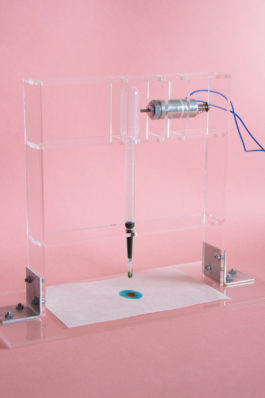
(4) color compositions
“Meist werden die Farben ‚Schwarz‘, ‚Rot‘, ‚Weiß‘, ‚Gelb‘ und ‚Braun‘ mit unterschiedlichen Hautfarben assoziiert. ‘[But] [w]ho has seen a black or red person, a white, a yellow, or brown?’ Auch diese Begriffe sind willkürliche Konstrukte und definitiv keine ‚(Farb)Wirklichkeiten‘. Der Gedanke, dass Menschen in unterschiedliche Farbkategorien gesteckt werden können, je nach dem was für ‚eine‘ Hautfarbe sie haben, wird schon an dem Punkt fragwürdig, wenn beachtet wird, dass allein eine Person schon ganz viele unterschiedliche Farbpigmente mit sich trägt und sich diese auch im Laufe des Jahres ändern können” [The colors ‘black’, ‘red’, ‘white’, ‘yellow’ and ‘brown’ are often associated with different skin tones. “[But] [w]ho has seen a black or red person, a white, a yellow, or brown?” These terms are arbitrary constructs and definitely not ‘(color)realities’. The idea that people can be put into different color categories, depending on what ‘one’ skin color they have, also becomes questionable when considering that every person carries many different color pigments with one and these can change throughout the year.] (Knilli 2021: 15).
A visual commentary on the absurd concept of wanting to put people into defined color categories based on the color of their skin. Many colors are compositions of a multitude of pigments – including skin tones. We don't just consist of one color pigment, but many different tones that create a constantly changing image.



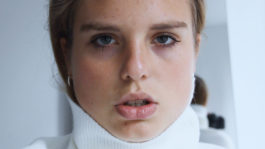







(5) hues
“Meist werden die Farben ‚Schwarz‘, ‚Rot‘, ‚Weiß‘, ‚Gelb‘ und ‚Braun‘ mit unterschiedlichen Hautfarben assoziiert. ‘[But] [w]ho has seen a black or red person, a white, a yellow, or brown?’ Auch diese Begriffe sind willkürliche Konstrukte und definitiv keine ‚(Farb)Wirklichkeiten‘. Der Gedanke, dass Menschen in unterschiedliche Farbkategorien gesteckt werden können, je nach dem was für ‚eine‘ Hautfarbe sie haben, wird schon an dem Punkt fragwürdig, wenn beachtet wird, dass allein eine Person schon ganz viele unterschiedliche Farbpigmente mit sich trägt und sich diese auch im Laufe des Jahres ändern können” [The colors ‘black’, ‘red’, ‘white’, ‘yellow’ and ‘brown’ are often associated with different skin tones. “[But] [w]ho has seen a black or red person, a white, a yellow, or brown?” These terms are arbitrary constructs and definitely not ‘(color)realities’. The idea that people can be put into different color categories, depending on what ‘one’ skin color they have, also becomes questionable when considering that every person carries many different color pigments with one and these can change throughout the year.] (Knilli 2021: 15).
Unfortunately the number of color pigments that each and everyone carries with them often stays unseen. but once you take a closer look: different hues ‘appear’ very clearly and become an individual color palette that changes continuously.

(6) mirrored with the truecolors-toolkit
“Es wird also ersichtlich, dass es anfangs nicht wegen technischen Umständen dazu kam, dass Weiße ‚besser‘ abgebildet werden ‚konnten‘ und teilweise immer noch ‚können‘ als People of Colour – sondern ganz im Gegenteil: Der Grund dafür ist, dass Weiße Entscheidungsträger*innen – in einer stark von Sexismus, Rassismus und Heteronormativität geprägten Industrie – Weiße als die Norm sahen und diese priviligierten. Auslöser dafür waren neben Unwissen und Ignoranz auch wirtschaftliche Interessen. Es gab und gibt zwar Möglichkeiten, diese normierten Gebrauchsformen, Strukturen und Technologien im Rahmen der fotografischen Medien zu umgehen, doch wird der Körper von People of Colour innerhalb dieses Diskurses ‘nur im Zusammenhang von Schwierigkeiten erwähnt’. So war es nur mit Hilfe von zusätzlichen Lichtquellen und technischen Anpassungen – die sich Fotograf*innen auch erst im Laufe der Jahre durch Erfahrung aneignen konnten – möglich, People of Colour annähernd abzubilden und sie somit (dauerhaft) sichtbar zu machen” [So it becomes clear that initially it was not due to technical circumstances that white people ‘could’ and partially still ‘can’ be depicted ‘better’ than People of Color – quite the opposite: the reason is that white people as decision-makers determined white people as the norm and privileged them in an industry heavily influenced by sexism, racism and heteronormativity. This was not only a consequence of lacking knowledge and ignorance, but also because of economic interests. While there were and are ways to circumvent these standardized uses, structures and technologies within the framework of photographic media, bodies of People of color always appear in the context of difficulties. It was only with the help of additional light sources and technical adjustments – which photographers have only been able to acquire over the years through experience – possible to approximately depict People of color and thus make them (permanently) visible.] (Knilli 2021: 18ff.).
A mirror (latin speculum ‘mirror’,‘image’ and specere ‘to see’) is a reflecting surface – smooth enough that reflected light retains its parallelism according to the law of reflection and thus an image can appear. Important: Any image can appear! The mirror is also an important component of the camera, but unfortunately, not everyone ‘could’ and partially still ‘can’ be depicted with this tool. Not because it wasn’t or isn't technically possible, but because parameters were set that way by white decision-makers. This paradoxon and absurdity is further underlined and emphasized with a symbolical spotlight in this project created with a specifically designed toolkit. The truecolors-toolkit is designed modularly which enables and animates one to deliberately set and change (technical) parameters.

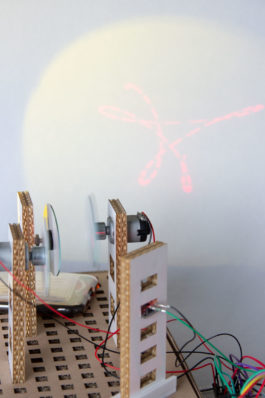
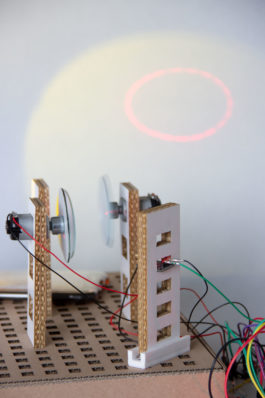


the truecolors-toolkit
The truecolors-toolkit aimes to be a tool with which one can understand, recreate, engineer and especially also question – and in the following step hopefully alter – physical phenomenas and technical conditions. Thanks to a modular plug-in system the toolkit can be permanently modified and expanded. With this in mind, materials were primarily used which can be easily altered and to which everyone should have relatively easy access: primarily cardboard and materials from the hardware store. When choosing the materials, it was also important to ensure that they are as sustainable as possible and that they could eventually either be recycled or reused for other purposes. The basic setup of the toolkit consists of: a big breadboard, an arduino nano, DC motors, an LED-module, rotary knobs, mirrors, color filters, all sorts of screws and washers, jumper wires, profiles and different cardboard plug-in elements. For this setup there are also instructions one can follow to mainly connect technical components. However, each and everyone working with this toolkit is explicitly animated to ignore, misuse or not use elements at all for their projects and extend the toolkit with individual components as well as materials – which underline the contributions to the discussion also visually.








Die wirkliche Farbe: Über Farbe und Wirklichkeitstreue
(true color: about color and truethfulness)
For my BA thesis/project I contemporaneously researched, wrote my thesis, explored how I could translate thoughts visually, sketched and did hands on prototyping. It went back and forth, often overlapped, but mainly everything influenced each other. A working method that was inspiring, but in my eyes also extremely necessary when talking about color – specifically also skin color –, technology – mainly photography and film –, representation, power structures and responsibilities.
In the course of this work I developed 6 projects that are linked to specific text passages in my thesis: color gradient (1) questioning the rigid categories we have defined for a fluid color spectrum; defining colors (2) touching on the absurdity of thinking that ‘objective’ color definitions work and the trust we give technology in being an ‘objective’ part (in this process); black and white reality (3) seeing that for a long time people lived in different ‘(color)realities’ and exploring how it is to walk trough a ‘black’ and ‘white’ world not just on photographs and in videos, but in real life; color composition (4) as well as hues (5) looking at the multitude of continuously changing hues each and everyone carries with their skin and the absurdity of assigning people to specifically determined color categories; and mirrored (6) with the truecolors toolkit I specifically designed learning how technology is calibrated, the interests, processes and power structures behind them, and seeing what effects (my) decisions (can) have. Feel free to read my thesis (in German).
–––––
tasks: concept, research, writing, prototyping, building, layout
2021 / Berlin University of the Arts (BA thesis & project)






















(1) color gradient
“Wir können zwar versuchen, Farbwerte mit Hilfe von Sprache zu vergleichen, doch ist es uns nicht möglich, anhand dieser abzuleiten, was die*der Sprecher*in ‚wirklich‘ sieht. Denn Farbbezeichnungen, wie beispielsweise ‚Gelb‘, ‚Grün‘ oder ‚Blau‘ setzen dem fluiden Farbspektrum scharfe Grenzen und gleichzeitig gehen wir mit diesen Bezeichnungen auch sehr ungenau um” [While we can try to compare color values with language, we can not determine what the person speaking ‘really’ sees. Color terms such as ‘yellow’, ‘green’ or ‘blue’ set sharp boundaries to a fluid color spectrum and at the same time we are very imprecise with designating these.] (Knilli 2021: 10ff.).
This work questions the rigid categories into which colors are often squeezed. With the help of a rotary knob one can find color values ‘in between’ – color values that often can not be clearly assigned to a specific color term. The ‘determined’ colors are therefore much more based on subjectivity – an individual interpretation – in contrast to the technical components, to which objectivity is usually ascribed.




(2) defining colors
“Eine von Geburt an nicht sehende Person würde meinen, dass ‘Farben wie Schach oder Mathe ein rein gedankliches [Konzept] sind. [Sie sind] abstrakt. [...] ‚Grün‘ und ‚Blau‘ sind wie Vokabeln [unter denen ich – Jonas Hauer – mir] nichts optisches vorstellen kann’” [A person without sight since birth would think that “colors are like chess or math a purely mental concept. They are abstract. ‘Green’ and ‘blue’ are like vocabulary among which I – Jonas Hauer – can't visualise anything.] (Knilli 2021: 11).
‘R244’, ‘G209’, ‘B220’ – What color is that? ‘RGB’ is another construct, a standardization and an attempt to describe and define colors ‘objectively’. But even if someone is familiar with the logic behind this definition and objectively seen it describes colors a lot preciser, most people probably don't really know which hue it describes. The only thing most people might know is: the tone is likely to be lighter rather than dark since the values are closer to 255 than 0 and that the color will lean towards ‘red’ rather than ‘green’ or ‘blue’ since ‘R’ is the highest value. On the other hand, if one would use color descriptions such as ‘red’, ‘pink’, ‘lilac’ or ‘violet’, one would most likely immediately have visual images in mind.
This project also plays with the trust people place in technologies and in this case specifically in color codes. One assumes an ‘objectivity’ that is often misleading, because it is not visible that devices are programmed and calibrated by individuals and are therefore ‘subjective’. Technology can never be fully ‘objective’, no matter how hard one tries.

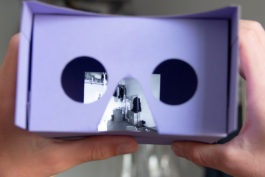
(3) black and white reality
“Lange war es auch technisch gar nicht möglich, eine ‚objektive‘ optische ‚Wirklichkeit‘ einzufangen. Erst mit der Erfindung der Fotografie Mitte des 19. Jahrhunderts und einige Jahrzehnte später dann auch mit dem Durchbruch des Filmes – beides ‚schwarz‘-‚weiß‘ – hat sich diesbezüglich viel verändert, denn Fotografie und Film wurden als wissen- schaftliche Werkzeuge eingeführt, die bis heute in der Regel ‘als exakt [und] empirisch, gänzlich im Dienste der Authentizität, Realität und Objektivität’ gesehen werden. Aber selbst ‚Schwarz‘-‚Weiß‘-Fotografie und -Film stellen eine gefilterte Version der visuellen ‚Wirklichkeit‘ dar, da das ‚Schwarz‘-‚Weiß‘-Bild für uns Menschen in der Regel nicht im realen Leben existiert” [For a long time it was also technically impossible to capture an ‘objective’ visual ‘reality’. Only with the invention of photography in the mid 19th century and a few decades later with the breakthrough of film – both ‘black’ and ‘white’ – a lot changed in this regard. Photography and film were introduced as scientific tools, which to this day are usually seen as “exact [and] empirical, wholly in the service of authenticity, reality and objectivity”. But even ‘black’ and ‘white’ photography and film represent a filtered version of visual ‘reality’, since for us humans the ‘black’ and ‘white’ image usually does not exist in real life.] (Knilli 2021: 12).
With ‘black’ and ‘white’ photography and film, one had the feeling of finally being able to depict ‘reality’. And for a long time, these were also the only images of such sort. It almost gives the feeling of having lived in different ‘(color)realities’, having to have used a lot of imagination or not having associated the visual ‘reality’ with a colored ‘reality’. At the same time the world is truly characterized by color and for many it is essential in defining a visual ‘reality’. So how does it feel to stride through a ‘black’ and ‘white’ world? With glasses and color filters, it is common practice to modify ‘our’ ‘(color)reality’. But a ‘black’ and ‘white’ ‘reality’ is usually left out, although the ‘black’ and ‘white’ world has been present and essential for so long. Therefore this device tries to enable experiencing a ‘black’ and ‘white’ world live with the help of simple means – a mobile phone camera, a ‘black’ and ‘white’ filter and a spectacle frame.

(4) color compositions
“Meist werden die Farben ‚Schwarz‘, ‚Rot‘, ‚Weiß‘, ‚Gelb‘ und ‚Braun‘ mit unterschiedlichen Hautfarben assoziiert. ‘[But] [w]ho has seen a black or red person, a white, a yellow, or brown?’ Auch diese Begriffe sind willkürliche Konstrukte und definitiv keine ‚(Farb)Wirklichkeiten‘. Der Gedanke, dass Menschen in unterschiedliche Farbkategorien gesteckt werden können, je nach dem was für ‚eine‘ Hautfarbe sie haben, wird schon an dem Punkt fragwürdig, wenn beachtet wird, dass allein eine Person schon ganz viele unterschiedliche Farbpigmente mit sich trägt und sich diese auch im Laufe des Jahres ändern können” [The colors ‘black’, ‘red’, ‘white’, ‘yellow’ and ‘brown’ are often associated with different skin tones. “[But] [w]ho has seen a black or red person, a white, a yellow, or brown?” These terms are arbitrary constructs and definitely not ‘(color)realities’. The idea that people can be put into different color categories, depending on what ‘one’ skin color they have, also becomes questionable when considering that every person carries many different color pigments with one and these can change throughout the year.] (Knilli 2021: 15).
A visual commentary on the absurd concept of wanting to put people into defined color categories based on the color of their skin. Many colors are compositions of a multitude of pigments – including skin tones. We don't just consist of one color pigment, but many different tones that create a constantly changing image.











(5) hues
“Meist werden die Farben ‚Schwarz‘, ‚Rot‘, ‚Weiß‘, ‚Gelb‘ und ‚Braun‘ mit unterschiedlichen Hautfarben assoziiert. ‘[But] [w]ho has seen a black or red person, a white, a yellow, or brown?’ Auch diese Begriffe sind willkürliche Konstrukte und definitiv keine ‚(Farb)Wirklichkeiten‘. Der Gedanke, dass Menschen in unterschiedliche Farbkategorien gesteckt werden können, je nach dem was für ‚eine‘ Hautfarbe sie haben, wird schon an dem Punkt fragwürdig, wenn beachtet wird, dass allein eine Person schon ganz viele unterschiedliche Farbpigmente mit sich trägt und sich diese auch im Laufe des Jahres ändern können” [The colors ‘black’, ‘red’, ‘white’, ‘yellow’ and ‘brown’ are often associated with different skin tones. “[But] [w]ho has seen a black or red person, a white, a yellow, or brown?” These terms are arbitrary constructs and definitely not ‘(color)realities’. The idea that people can be put into different color categories, depending on what ‘one’ skin color they have, also becomes questionable when considering that every person carries many different color pigments with one and these can change throughout the year.] (Knilli 2021: 15).
Unfortunately the number of color pigments that each and everyone carries with them often stays unseen. but once you take a closer look: different hues ‘appear’ very clearly and become an individual color palette that changes continuously.




(6) mirrored with the truecolors-toolkit
“Es wird also ersichtlich, dass es anfangs nicht wegen technischen Umständen dazu kam, dass Weiße ‚besser‘ abgebildet werden ‚konnten‘ und teilweise immer noch ‚können‘ als People of Colour – sondern ganz im Gegenteil: Der Grund dafür ist, dass Weiße Entscheidungsträger*innen – in einer stark von Sexismus, Rassismus und Heteronormativität geprägten Industrie – Weiße als die Norm sahen und diese priviligierten. Auslöser dafür waren neben Unwissen und Ignoranz auch wirtschaftliche Interessen. Es gab und gibt zwar Möglichkeiten, diese normierten Gebrauchsformen, Strukturen und Technologien im Rahmen der fotografischen Medien zu umgehen, doch wird der Körper von People of Colour innerhalb dieses Diskurses ‘nur im Zusammenhang von Schwierigkeiten erwähnt’. So war es nur mit Hilfe von zusätzlichen Lichtquellen und technischen Anpassungen – die sich Fotograf*innen auch erst im Laufe der Jahre durch Erfahrung aneignen konnten – möglich, People of Colour annähernd abzubilden und sie somit (dauerhaft) sichtbar zu machen” [So it becomes clear that initially it was not due to technical circumstances that white people ‘could’ and partially still ‘can’ be depicted ‘better’ than People of Color – quite the opposite: the reason is that white people as decision-makers determined white people as the norm and privileged them in an industry heavily influenced by sexism, racism and heteronormativity. This was not only a consequence of lacking knowledge and ignorance, but also because of economic interests. While there were and are ways to circumvent these standardized uses, structures and technologies within the framework of photographic media, bodies of People of color always appear in the context of difficulties. It was only with the help of additional light sources and technical adjustments – which photographers have only been able to acquire over the years through experience – possible to approximately depict People of color and thus make them (permanently) visible.] (Knilli 2021: 18ff.).
A mirror (latin speculum ‘mirror’,‘image’ and specere ‘to see’) is a reflecting surface – smooth enough that reflected light retains its parallelism according to the law of reflection and thus an image can appear. Important: Any image can appear! The mirror is also an important component of the camera, but unfortunately, not everyone ‘could’ and partially still ‘can’ be depicted with this tool. Not because it wasn’t or isn't technically possible, but because parameters were set that way by white decision-makers. This paradoxon and absurdity is further underlined and emphasized with a symbolical spotlight in this project created with a specifically designed toolkit. The truecolors-toolkit is designed modularly which enables and animates one to deliberately set and change (technical) parameters.


the truecolors-toolkit
The truecolors-toolkit aimes to be a tool with which one can understand, recreate, engineer and especially also question – and in the following step hopefully alter – physical phenomenas and technical conditions. Thanks to a modular plug-in system the toolkit can be permanently modified and expanded. With this in mind, materials were primarily used which can be easily altered and to which everyone should have relatively easy access: primarily cardboard and materials from the hardware store. When choosing the materials, it was also important to ensure that they are as sustainable as possible and that they could eventually either be recycled or reused for other purposes. The basic setup of the toolkit consists of: a big breadboard, an arduino nano, DC motors, an LED-module, rotary knobs, mirrors, color filters, all sorts of screws and washers, jumper wires, profiles and different cardboard plug-in elements. For this setup there are also instructions one can follow to mainly connect technical components. However, each and everyone working with this toolkit is explicitly animated to ignore, misuse or not use elements at all for their projects and extend the toolkit with individual components as well as materials – which underline the contributions to the discussion also visually.






